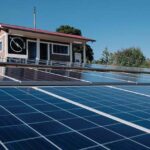Mini-grids—smaller off-grid electricity distribution networks—are being recognized as a cost-effective solution to bring power to rural communities that often have no access to a traditional power grid. They also are being used as proving grounds for new configurations of power generation technologies. Though the generation parameters for mini-grids vary, the United Nations Framework Convention on Climate Change defines a mini-grid as having fewer than 15 MW of generation capacity, and as an installation disconnected from a larger power grid.
The World Bank and the International Energy Agency, among others, have identified mini-grids as a way to bring electricity to billions of people worldwide who do not have access to a reliable power supply. Major energy companies are entering the space. ENGIE inaugurated its first PowerCorner mini-grid in Zambia in April 2019, and has since added more than a dozen installations on the continent. ENGIE has a goal of developing 2,000 mini-grids in Africa by 2025. India’s Tata Power has a similar project in its home country.
The African Development Bank (AfDB) in December 2020 announced a $7 million grant to help Africa’s mini-grid sector develop up to 80 MW of new generation capacity, along with attracting $650 million of investment from the private sector. The Sustainable Energy for Africa (SEFA) funding stream was established by Denmark in 2011, and is supported by public money from Italy, Norway, Spain, Sweden, the UK, and the U.S. The growth of the mini-grid market comes as countries face objectives of increasing the availability of electricity to households and businesses, while at the same time reducing dependency on fossil fuels, usually by adopting renewable energy or other lower-carbon technologies.
 |
|
1. Husk Power’s mini-grids are in use in India (shown here) and Africa. The mini-grid concept is growing as a way to provide electricity to areas with limited or no access to power. Courtesy: Husk Power / YouTube |
An example of this is a mini-grid project in India, an installation by Husk Power Systems, a Colorado-based company that operates more than 100 community mini-grids across Asia and Africa. The India facility (Figure 1), located in Chanpatia, in Bihar state, has about 160 customers, and serves a mix of residences and businesses.
The mini-grid provides renewable generation through a hybrid set-up of solar photovoltaic (PV) and biomass gasification, along with battery storage. Rice husks and corn cobs provide the fuel for the gasifiers. The system includes fully automated process management for the biomass gasification, with a mix of DC plus AC coupling for solar PV to enhance system efficiency and modularity, according to Husk. The lithium-ion-based energy storage helps reduce system losses and enhances the PV utilization during periods of peak power demand.
The mini-grid can be remotely managed and monitored, and is supported by a “state-of-the-art forecasting engine to alert for demand supply gaps and necessary resolution steps,” according to Husk. The mini-grid concept is part of the global trend for privatization of power distribution companies, or DISCOMs, and a solution to providing power to what are often called “last-mile communities,” areas unable to connect to a traditional power grid. Mini-grid developers are bringing electricity to these areas, driving socio-economic improvements, and improving the quality of life in those regions.
Manoj Sinha, CEO of Husk Power, told POWER that the drivers of the mini-grid market are different in developed nations versus installations in the developing world. “In the Western market, in the U.S. and Europe, it’s about resiliency and integrating renewable assets onto the grid, mostly on the battery side,” Sinha said. He noted that natural disasters, including fires in California and situations that have prompted public safety power shutoffs, “catapulted the need for the mini-grid and microgrid concept. That includes when an electric vehicle can act as a source of power, both for the grid and for the household,” he said. He added that “the developing market is a completely different set of drivers. We started the mini-grid market in my home state of Bihar in India. The whole concept of doing decentralized power generation and distribution was to bring power to people without access to electricity.” The SEFA funding, known as the Africa Mini-grid Market Acceleration Programme, reportedly would initially provide 880,000 new electricity access points for 4 million people on the continent.
“When we started this in 2008, I had to explain what a mini-grid is,” said Sinha, referring to Husk’s development of the technology. “I don’t have to do that any longer.” He said mini-grids are a good solution because they provide “a more capital-efficient way to bring power to people, and it also tackles climate change as part of the equation. The technology plays a huge role in making this happen. Hundreds of thousands of mini-grids spread across Asia and Africa, to be able to effectively manage these geographically disparate assets, we need a management system, and doing it all automatically, based on machine learning. Most mini-grid companies don’t talk about levelized cost of energy (LCOE), and LCOE is one thing we manage very, very carefully. In developing markets, the cost [of power] matters a lot more. They’re looking at getting high-quality power that meets their basic needs.”
Sinha said balancing power costs with reliability is critical as electricity is brought to developing markets. “That can be best served by mini-grids,” he said. “These can provide that source of high-quality, high-reliability power. Areas such as India, and sub-Saharan Africa, these regions need to have mini-grids as part of a national power infrastructure program.”
As noted earlier, these mini-grids also provide opportunities for new configurations of power systems. Other aspects of the Bihar mini-grid include aerial bunched cables with large cross sections to minimize distribution losses, along with low-tension distribution “via adequate protection systems to minimize plant downtimes and increase system life.”
The system also includes “smart metering with totalizers at each junction to easily trace and track distribution losses across the grid,” as well as an integrated water purification system to enhance PV utilization and “extend the value chain for energy,” according to Husk. The company said that as of late 2020, its 100 mini-grids in India and Africa, including Tanzania and Nigeria, “represent a more than 10-fold increase from mid-2018. Average capacity of the mini-grids is 50 kW, a system size that is significantly larger than most other rural energy service providers and able to power multiple productive loads for a range of small businesses, including retail shops, factories, agricultural processing and cold storage, water filtration, and schools, as well as households.”
Said Sinha: “We’re now able to roll out at least two new mini-grids per week, one of the fastest growth rates in the industry, and there is still considerable room for acceleration.” Sinha noted that the company plans to double its mini-grid fleet this year, with a “vision of reaching 5,000 mini-grid sites serving 500,000 micro-enterprise customers” in the coming years.
—Darrell Proctor is associate editor for POWER.









